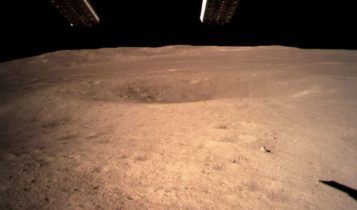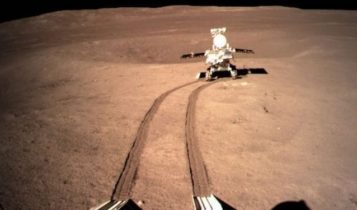© 2000-2023 - Enkey Magazine - All rights reserved
ENKEY SNC - VAT ID IT03202450924 / REA Code CA253701 - Phone. 078162719
The dark side of the Moon always generated doubts and perplexity. A face that never turns toward the Earth and that hides who knows what mistery. Especially since no probes never landed on that side of our natural satellite.
Chang’e-4 is the first probe to land on the dark side of the Moon and now it’s going to move its first steps.
The dark side of the Moon

Like we said no one never put a feet on the dark side of the Moon. The face of the satellite which doesn’t look at the planet Earth is much different then the one that we can, instead, daily see.
While the visible face is characterised by big lava plains, the hidden one is rich of craters.
The China, with its lunar probe Chang’e-4, signs so an important primacy in the space exploration. Another really interesting result, happened in the 2013, with the lunar landing of Chang’e-3, this time on the visible side of the Moon.
The predecessor of the last chinese probe, was the first one to come back on the satellite after the mission Moon-24 of the 1976.
By the way a lunar landing on the dark side of the Moon isn’t something easy to realise. Not being the site directly visible from the Earth, the team had to solve the problem with a repeater.
The satellite Queqiao
The satellite Queqiao was launched the last May in a halo orbit around the point Langragiano L2 Earth-Moon, between the 65.000 and the 85.000 km from the lunar surface. That point will allow to look at the same time both the dark side of the Moon and the planet Earth.
From there the satellite is able to link and to communicate with the probe and the rover Chang’e-4 and with the control station from the Earth.
Launch and landing
The last 8th of December the probe was launched on board of the rocket Lunga Marcia 3B/E, after almost one month and with not few doubts about it, it touched the lunar ground the 3th of January of the 2019 at the 3:26 (italian hour).
The probe took place, like predicted, in the crater Karman. The chosen area is geologically really interesting, becuase is a part of the complex of craters South-Pole Aitken Basin, an area which goes from the South Pole until the crater Aikten.
An area of around 2500 km of diameter and 11000 km of circumference. It is considered that the area was interested by huge and violent meteorite strikes, about 3,6 billions of years ago.
The lander and the rover

The probe Chang’e-4 weights 12.000 kg and it just released the small rover Yutu 2 which already made its first steps on the lunar ground.
Yutu 2 weights 140 kg and it will have the duty to explore the area. Both of them already sent the first images back on the Earth.
They will both study the soil’s composition, thanks to the Low Frequency Spectrometer of the lander and the Visible and Near Infrared Imaging Spectrometer of the rover.
Therefore, thanks to the Lunar Penetrating Radar, on board of Yutu 2, it will be possible to study even the geological structure of the underground.
The mission
Besides to study the soil and the underground’s composition, of the not visible side of our natural satellite, the mission Chang’e-4 wants to do even many other purposes.
During the mission they will use even instrumentations from other part of the world, that, with the chinese space agency made an agreement.
The Lunar Lander Neutrons and Dosimetry Experiment, for example, developed in Germany and the swedish Advanced Small Analyser for Neutrals, will study the radioactive environment and the effects of the solar wind on the lunar surface.
Finally, with the hope of a futur human lunar outpost, that since a while hovers in the thougths of the chinese agency, the probe will even looks for the water. It seems, infact, that right in the crater Karman, is hidden some ice.
To finish Chang’e-4 brings with it even an experiment from a group of university students: the mini lunar biosphere. This is a small cylindrical box, with a volume of 80cc which contains air, water and nutritional substances.
Together with them there are potatos and Arabidopsis seeds (flower really used in the experiments), as weel as eggs of silkworm. The cylinder, checked by a camera, will see the birth of the life on the Moon.
This post is also available in:
![]() Italiano
Italiano
